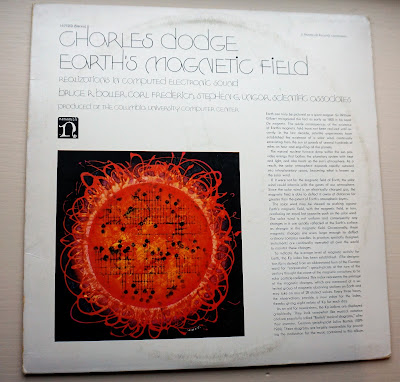On NPR's Weekend Edition Sunday (NPR is a favorite news source in our household), there was a story about the The Music of the Northern Lights. Composer Matthew Burtner created a piece of music called Auroras by recording very low frequency emissions of aurorae (4th area of study for the IGY) and transforming them into audio.
This is an example of sonification, the process of turning non-aural information into sound. Below, I'll present several examples of how different types of geophysical data have been turned into audible sounds.
My favorite example of geophysical sonification is a composition by Charles Dodge. His 1970 piece Earth's Magnetic Field is based on note-keeping methods for so-called Kp indices, which represent short-term changes in the global magnetic field (3rd area of study for the IGY), which can be transposed into musical notation.
I bought this on vinyl in the mid-1970s at my favorite record store in Tucson when I was in graduate school. I still have it:
 |
| Charles Dodge, Earth's Magnetic Field (1970), front album cover |
 | |
|
 | |
|
I scanned the liner notes for the album (vinyl! albums! liner notes!) which give a nice description of how this piece was produced. Rather than inserting those lengthy comments in the blog, I posted them here. I could not find these anywhere else online.
NASA has posted a sonification of vibrations of the sun here. Solar activity is the 6th area of study for the IGY.
The catalog for Smithsonian Folkways Recordings (usually for folk music) includes a 1955 recording, Ionosphere. This effort was a product of Cook Laboratories, run by renowned audio engineer Emory Cook. The ionosphere was the 5th area of study for the IGY.
The solid Earth makes sound as well. Pre-sonification, the Seismological Society of America (located a stone's throw from where my older son lives in El Cerrito, CA) posted a collection of 21 earthquake related sounds, prepared by Karl V. Steinbrugge, originally published in 1974 and updated with eight additional sounds in 1985. The collection was sold by the Society for many years, originally as an audio cassette tape which I once owned, but I think I discarded it after I retired. Here, for example, is the voice of a man rather excited by the Great Alaskan Earthquake of 1964.
But seismic waves are very amenable to sonification. Ben Holtzman, a geophysicist at Lamont-Doherty Geophysical Observatory, Columbia University, has co-produced audio and visual representations of seismic wave data, including a representation of the 2011 magnitude 9 (4th largest in history) Tohoku Earthquake. Sonification of other significant earthquakes (including the 2004 m=9.1 Sumatran quake, third largest in history) produced by this group can be found here. Seismology was the 12th area of study for the IGY, so 5 of those 14 areas of geophysical study are represented in this post.
You can find some other cool examples of geophysical sonification on your own.
There are also some popular songs that refer directly to the IGY, but that's another post.
Great post!
ReplyDeleteI have a few thoughts:
1) How stoned do you think the typical listener of the "Earth's magnetic field" was? (No need to answer about yourself, though I could only imagine while listening...)
2) I really liked some of the audio-visual material on the Lamont-Doherty website - excellent.
3) Now I'm curious about sonification of other scientific data. A quick Google search of "genome sonification" turns up this recent peer-reviewed (and open access) article on sonification of the Coronavirus genome... neat! And plenty of other entries for sonification and DNA/genes.
Perhaps related to 1), I can add that the composer Charles Dodge and his wife later co-founded a winery in Vermont, Putney Mountain Winery and Spirits (https://putneymountainwinery.com/our-team/).
ReplyDelete